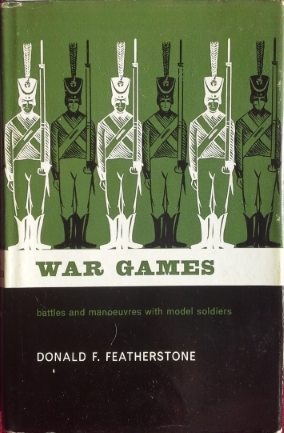While I am still not in a painting and gaming mood, I am continuing to read about playing with toy soldiers and military history. Indeed my last book was one that proved seminal to the rise of modern wargaming. A little while ago I was fortunate to secure on EBay a 1972 edition copy, in good condition, of Donald Featherstone’s 1962 book “War Games Battles and Manoeuvres with Toy Soldiers”. Reading it proved to be a fascinating journey into the past and the start of wargaming as a popular hobby.

After a foreword by the esteemed Brigadier Peter Young, the book explains what wargames are and how you go about setting them up. Campaigns are broadly described and solo games are also briefly covered. Having elucidated wargaming to the reader, Donald Featherstone provides a collection of five rules for gaming periods from the ancient world to World War 2 (or Modern as it is referred to in the book). The rules are supported with exciting battle reports and photographs showing how the conflicts play out.
The first rules, by the revered Tony Bath, cover ancient warfare. These are demonstrated by the fantasy battle of “Trimsos” between the Hyperboreans and the Hyrkanians using zinnfiguren. The second set of rules address horse and musket warfare. These are illustrated by an American Civil War battle called “Action in the Plattville Valley” where blue and grey shiny toy soldiers fight over hills made of plasticine. The venerable Lionel Tarr’s highly detailed modern (i.e. WWII) rules are the next to be explained, followed by a simplified set for less rigorous games. The simple modern rules are then exhibited through a WWII “Tank and Infantry Action on the St James Road” between British Grenadier Guards, with supporting miniature tanks, and the Herman Goering Panzer Grenadiers, with homemade panzers of plaster. The last set of rules, “Close Wars”, appear in the appendices and are designed for skirmish actions in the French and Indian War of the 18th Century. The appendices also contain instructions for making Lionel Tarr’s wargaming periscope.
While “War Games Battles and Manoeuvres with Toy Soldiers” may not be as relevant to wargamers as it was when it was first published some 55 years ago it still inspires. It certainly gives some insight into the thinking of past wargaming worthies on rules and playing wargames. The rules supplied within the book are quite playable and the thrilling battle reports are still a pleasure to read. The book also demonstrates quite brilliantly that good fun games can be played without all the frippery and paraphernalia of modern wargaming. In short, the book is a word to the wise and a tonic for the jaded.
I hope you make a periscope, that would be a real hoot! 🙂
LikeLike
All the better to see you with! 🙂
LikeLike